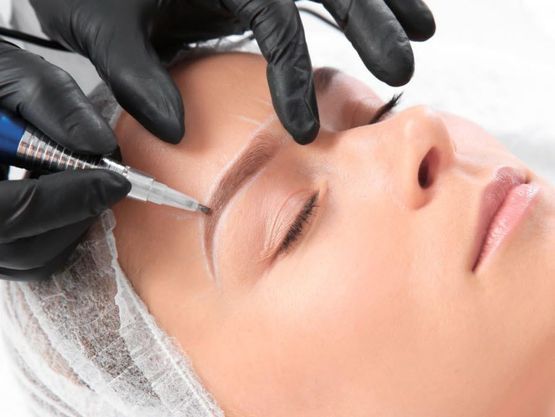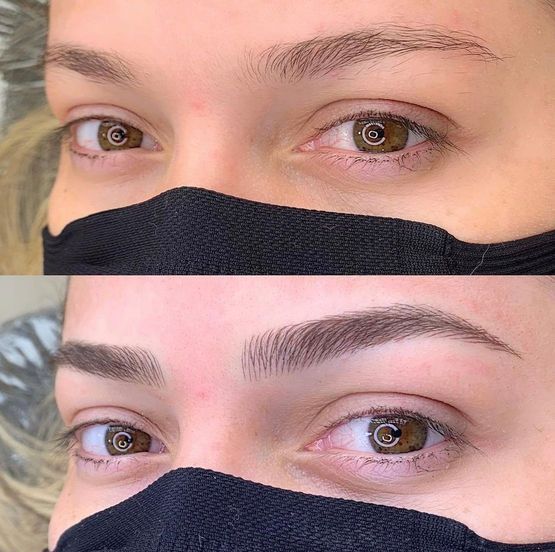Microblading and shading
Advanced techniques to enhance your look



Microblading,
Microblading is carried out using a handheld tool containing nano-needles joined together on the same line which form a fine blade.
Thanks to the thinness of the nano-needles, the line will be ultra thin, and your eyebrows will blend in perfectly and look natural, imitating hair perfectly.
The PhiBrows method uses a formula to calculate very precise proportions, taking into account the dimensions of the face and your needs.
PhiBrows pigments contain no harmful heavy metals, are high quality and don’t change colour.
Microshading
Microshading is a semi-permanent method of filling eyebrows to make them look fuller, thicker and more natural. The aim is to fill the eyebrow with a shading effect that fades out, creating a natural result. Thanks to its powdery finish, microshading gives the illusion of a lightly made-up eyebrow.
The pigment is chosen with care depending on the hair’s natural colouring.
Using a dermograph, the practitioner injects the semi-permanent pigments under the skin, taking care to create a well-blended gradient. After a session, the result is quite thick and dark but don’t panic! It hasn’t failed. The intensity fades slowly to create a perfect eyebrow after a month. Similarly, redness may appear around the eyebrows. This will disappear after a few days. You’ll then need one or two retouches a year.
Microblading & Microshading
Menu
(2h30)
(1h30)
(1h30 to 2h)
Treatment at another institute
The difference between permanent make-up and microblading
Unlike permanent make-up, which can sometimes turn red or blue/green, microblading is stable and fades gently depending on skin type.
This technique consists of pigmenting the upper layers of the epidermis, it only going 0.2 – 0.3 mm deep, while permanent make-up done with an electric dermograph goes up to 0.5 – 0.8 mm.
Microblading doesn’t damage the capillaries or touch the follicles so there’s no issue with hair regrowth.
Precautions
24 hours before your appointment: avoid aspirin, blood-thinning drugs, vitamins, omegas, alcohol and drugs.
30 days before your appointment: avoid chemical facial treatments, peelings, fruit acids, laser treatments and Botox.
Frequently asked questions
Take a look at some of our FAQs and please get in touch if you want to know more.
Post-treatment and healing
Your technician will give you a protective cream to ensure your skin heals well over the next few days.
Half an hour after your treatment, rinse your eyebrows with lukewarm water and apply the protective cream.
This procedure must be repeated every hour, at least five times a day.
Good hygiene will prevent scabs forming. The pigment intensity will fade by around 40% after the first 10 days.
What to avoid the week following treatment
All creams (except the protective cream advised by your technician), facial treatments, chemical treatments such as peelings, any make-up in the eyebrow area and swimming pools.
Avoid activities which cause you to sweat a lot: saunas, hammam, steaming, inhalation, intensive exercise.
What do avoid for 30 days after the treatment
Sun exposure, solarium, light therapy, skin peels, fruit acid, micro-dermabrasion, regenerating cream, laser treatments, Botox in the area above the eyes so as not to destroy the pigment and cause burns.
Taking antibiotics or hormones can also lead to depigmentation. Always use sun cream to protect your eyebrows (except for in the first seven days).
How long does microblading last?
Microblading pigments normally last one to three years depending on your skin type.
Since microblading works on the epidermis surface (approximately 0.2 mm), the pigments will naturally and gradually disappear with natural cell renewal.
Retouches
A first retouch is essential a month after your first treatment for an even result.
We then recommend having a retouch every ten to twelve months. Some skin types will need more regular retouches.
Is it painful?
The feeling is similar to small scratches and can vary depending on your sensitivity.
Don’t have this treatment if
you’ve had a skin peel, laser treatment, dermabrasion, light therapy, Botox injections or hyaluronic acid skin treatments a month before microblading (avoid these treatments for a month after as well);
- you’re pregnant;
- you’re breastfeeding;
- you’re a minor (except with parental consent);
- you have uncontrolled diabetes (only with medical advice);
- you have an infection or virus;
- you have HIV or hepatitis;
- you have an auto-immune condition;
- you’ve had chemotherapy in the last six months;
- you’ve had an organ transplant;
- you have keloid scarring;
- you have a bleeding disorder;
- you have cardiovascular issues;
- you’re taking an anticoagulant drug;
- you have a skin condition, eczema or herpes;
- you have epilepsy.
What is eyebrow reshaping?
This consists of reconstituting the eyebrow shape depending on your face shape.
Eyebrows play an important role. They let you express your emotions, they balance your facial features and enhance your look.
A successful reshaping corrects some imbalances and asymmetry.
Make an appointment online
Address
Institut Royal
Place de Cornavin 14/16
1201 Genève
Phone
079 362 32 37
Email
granziera.dounia@yahoo.fr
Legal


